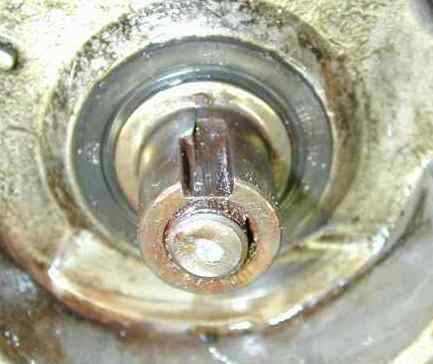
1. Worn Keyway
2. Holy cow, the crankbolt
is broke!
 |
What's wrong with this picture?
1. Worn Keyway 2. Holy cow, the crankbolt
|
It was an awful moment. When I began to remove
the crank bolt, it was finger tight and easily spun a half turn , allowing
the pulley to move with the slop in the keyway. After two more turns,
it tightened up. I should have just rocked it back and forth, but being
impatient, I hooked on a two foot breaker bar and the bolt
head snapped off. Was it time to look for a replacement engine?
| This is a screw extractor. It's inserted into a
hole drilled into the body of the bolt. It jams against the sides of the bolt when twisted counterclockwise. If all goes well, the bolt comes out.
|
 |
This job looked especially difficult. I would have to drill a hole into the remainder of the bolt shaft, keep it more or less parallel with the shaft, and then get enough force with a screw extractor to back it out. The one thing I wanted to avoid was breaking off the extractor inside the bolt. They're made of hard steel and are almost impossible to drill out if broken.


With a brand new bit in my Craftsman drill, I made a starter hole in the bolt shaft. The metal was fairly soft. I then put in the 5/16" drill specified for my extractor tool and drilled almost to the end of the bolt.


The above pictures show the extractor hammered into the drilled hole and the setup I used to torque it. The original bolt with a 21 mm head had snapped off when I applied over 100 ft-pounds with a breaker bar. I was not very optimistic about getting that kind of force on the 1/4" head (6.2 mm) of the extractor. I looked in vain for a square 1/4" socket in the stores. Finally, I slipped the square drive end of a 1/4" socket over the extractor and tried different ways to grip it. The above shows my final setup. The 1/4 socket end grabs the extractor. A piece of hex stock between that socket and a second socket on a breaker bar allowed plenty of torque. I ripped two sockets apart and the bolt never budged.


The above pictures show the removal process and the final success. I sure felt good. Note the burn marks on the outside of the crankshaft seal.


So that's the end of this tale. I've owned a set of Craftsman
Screw Extractors for years, but this is the
first time I ever used them successfully.
![]()